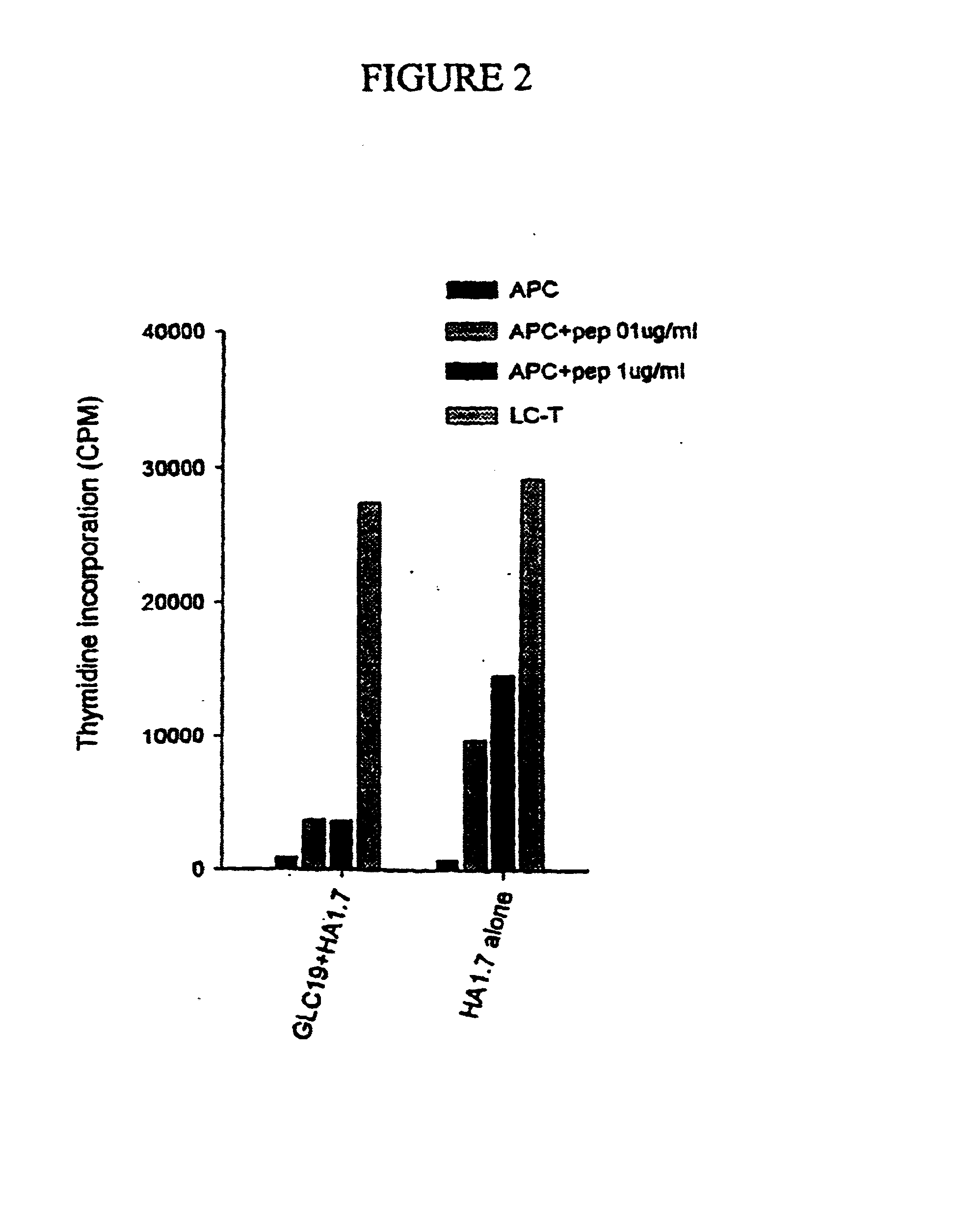Immunotherapy
a technology of immunotherapy and tumour cells, applied in the field of immunotherapy, can solve the problems of inability to mount an effective immunological response to the tumour, and have side effects that affect the effect of treatment effect, and achieve the effect of inhibiting t cell responses and preventing tumour cells from inducing immunotoleran
- Summary
- Abstract
- Description
- Claims
- Application Information
AI Technical Summary
Benefits of technology
Problems solved by technology
Method used
Image
Examples
example 1
Small Cell Lung Tumour Cells Express Components of the Notch Signalling Pathway
[0184] Small cell lung tumour cell (SCLC) lines (GLC-19, NCI-H69, NCI-H345, NCI-H711, Lu-165, COR-L24 and COR-L188) and non-small cell lung tumour cell (NSCLC) lines (NCI-H460, MOR / P, COR-L23 and A549) were grown in culture medium (RPMI-1640) supplemented with 10% foetal calf serum in tissue culture flasks and maintained at a density of 2-5.times.10.sup.6 cells per ml. Cells were collected and centrifuged at 1500 rpm resuspended in lysis buffer and total RNA extracted. RNA is prepared from cell pellets by homogenisation in guanidium thiocyanate solution followed by CsCl density centrifugation.
[0185] RT-PCR was performed using an Access RT-PCR kit (Promega). One .mu.g of total RNA was used in each reaction together with specific oligonucleotide primers (50 pmol) for the following human genes--Delta1, Jagged (Serrate) 1 and 2, hASH-1, Notch 1, 2 and 3, Radical fringe (controls actin and GAPDH)--and murine g...
example 2
Induction of Unresponsiveness in Human T Cells Following Interaction with SCLC Cells
[0198] Cloned human CD4.sup.+ T cells (HA1.7), as described in Lamb et al. (1983), were cultured at 2.times.10.sup.6 cells per well in 12 well tissue culture plates together with irradiated (6000 rads) SCLC (GLC19) at 0.5.times.10 per well for 24 hours or alone in tissue culture medium (RPMI-1640 supplemented with 10% human A.sup.+ serum).
[0199] The T cells were then restimulated with irradiated (6000 rads) autologous EBV transformed B cells (2.5.times.10.sup.4 per well, as a source of antigen presenting cells) together with increasing concentrations of cognate peptide (influenza) virus haemagglutinin residues 306-318, at 0.1 or 1 .mu.g / ml) or in Interleukin 2 (IL-2; 10% v / v) alone in 96 well tissue culture plates. The cell cultures were pulsed with tritiated thymidine (3[H]-TdR, 0.1 .mu.Ci per well) and harvested 72 hours after the initiation of the cultures. The incorporation of 3[H]-TdR as a measu...
example 3
The Serrate-1 Gene is Expressed in Melanoma Cell Lines
[0202] Mouse melanoma cell lines MC57 and B16F10 were cultured in RPMI-1640 medium with 10% FCS at 37.degree. C. Cells were collected and centrifuged at 1500 rpm, resuspended in lysis buffer and total RNA extracted.
[0203] RT-PCR was performed using an Access RT-PCR kit (Promega). 50 ng RNA was used in each reaction together with Serrate-1 gene specific oligonucleotide primers (50 pmol) under conditions according to the manufacturer's instructions (T.sub.m for the Serrate oligonucleotides=58.degree. C.).
[0204] The sequence of the "forward" Serrate-1 primer is:
3 The sequence of the "forward" Serrate-1 primer is: 5'-GGCTGGGAAGGAACAACCTG-3' The Serrate-1 "reverse" primer is: 5'-GGTAGCCATTGATCTCATCCAC-3' Primers specific for Delta are: 5'-GATTCTCCTGATGACCTCGC-3' and 5'-GTGTTC GTCACACACGAAGC-3'
[0205] A PCR-product of the predicted size (330 bp) was observed from RNA obtained from each of the two melanoma cell lines. No Delta-specific P...
PUM
| Property | Measurement | Unit |
|---|---|---|
| temperature | aaaaa | aaaaa |
| concentrations | aaaaa | aaaaa |
| concentrations | aaaaa | aaaaa |
Abstract
Description
Claims
Application Information
 Login to View More
Login to View More - R&D
- Intellectual Property
- Life Sciences
- Materials
- Tech Scout
- Unparalleled Data Quality
- Higher Quality Content
- 60% Fewer Hallucinations
Browse by: Latest US Patents, China's latest patents, Technical Efficacy Thesaurus, Application Domain, Technology Topic, Popular Technical Reports.
© 2025 PatSnap. All rights reserved.Legal|Privacy policy|Modern Slavery Act Transparency Statement|Sitemap|About US| Contact US: help@patsnap.com


